
The Marine Biological Laboratory (MBL) is an international center for research and education in biological and environmental science. Founded in Woods Hole, Massachusetts, in 1888, the MBL is a private, nonprofit institution that was independent for most of its history, but became officially affiliated with the University of Chicago on July 1, 2013. It also collaborates with numerous other institutions.

John Alexander Church is an expert on sea level and its changes. He was co-convening lead author for the chapter on Sea Level in the IPCC Third Assessment Report. He was also a co-convening lead author for the IPCC Fifth Assessment Report. He is a member of the Joint Scientific Committee of the WCRP. He was a project leader at CSIRO, until 2016. He is currently a professor with the University of New South Wales' Climate Change Research Centre.
Farooq Azam is a researcher in the field of marine microbiology. He is a Distinguished Professor at the Scripps Institution of Oceanography, at the University of California San Diego. Farooq Azam grew up in Lahore and received his early education in Lahore. He attended University of Punjab, where he received his B.Sc. in chemistry. He later he received his M.Sc. from the same institution. He then went to Czechoslovakia for higher studies. He received his PhD in microbiology from the Czechoslovak Academy of Sciences. After he received his PhD, Farooq Azam moved to California. Azam was the lead author on the paper which coined the term microbial loop. This 1983 paper involved a synthesis between a number of leaders in the (then) young field of microbial ecology, specifically, Azam, Tom Fenchel, J Field, J Gray, L Meyer-Reil and Tron Frede Thingstad.
Paul Kuykendall Dayton is a biological oceanographer and marine ecologist at the Scripps Institution of Oceanography. Dayton works in benthic ecology, marine conservation, evolution, natural history, and general ecology.
Winston Frank Ponder is a malacologist born and educated in New Zealand who has named and described many marine and freshwater animals, especially micromolluscs.
Edward Brinton was a professor of oceanography and research biologist. His particular area of expertise was Euphausiids or krill, small shrimp-like creatures found in all the oceans of the world.

Nancy Knowlton is a coral reef biologist and a former Sant Chair for Marine Science at the Smithsonian National Museum of Natural History.
Sabine Dittmann is an Australian-based marine biologist and expert on the ecology of tidal flats. She is Associate Professor of Marine Biology at Flinders University in Adelaide, and is President of the Australian Marine Sciences Association.
The ruby seadragon is a marine fish in the family Syngnathidae, which also includes seahorses. It inhabits the coast of Western Australia. The species was first described in 2015, making it only the third known species of seadragon, and the first to be discovered in 150 years. A specimen found on shore in 2007 was 23.5 cm (9.3 in) long.
Deborah K. Steinberg is an American Antarctic biological oceanographer who works on interdisciplinary oceanographic research programs. Steinberg's research focuses on the role that zooplankton play in marine food webs and the global carbon cycle, and how these small drifting animals are affected by changes in climate.
Helen Amanda Fricker is a glaciologist and professor at Scripps Institution of Oceanography at the University of California, San Diego where she is a director of the Scripps Polar Center. She won the 2010 Martha T. Muse Prize for Science and Policy in Antarctica.

In-Young Ahn is a South Korean scientist. She is known for being the first South Korean woman to visit Antarctica and the first Asian woman to become an Antarctic station leader. She is a benthic ecologist and is currently working as a principal research scientist for the Korea Polar Research Institute.
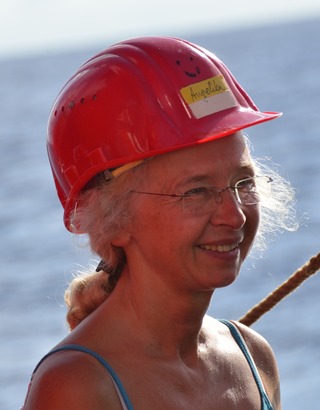
Angelika Brandt is the world leader in Antarctic deep-sea biodiversity and has developed, organised and led several oceanographic expeditions to Antarctica, notably the series of ANDEEP cruises, which have contributed significantly to Antarctica and deep-sea biology. Brandt was the senior scientist of ANDEEP which was devoted entirely to benthic research in the Antarctic abyss.

Jan Maree Strugnell is an Australian evolutionary molecular biologist. She is a professor and director in the Centre for Sustainable Tropical Fisheries and Aquaculture at James Cook University, Townsville, Australia. Strugnell's work has investigated population and species level molecular evolution in Antarctic and deep sea species in the context of past geological and climatic change. Strugnell's work also uses genetic tools to help solve bottlenecks in aquaculture and fisheries industries.
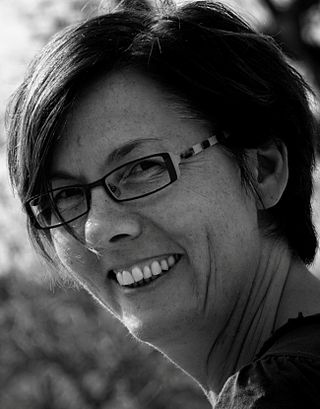
Bettina Meyer is a German Antarctic researcher, best known for her work on the ecology and physiology of invertebrates in the pelagic zone. She is the head of the ecophysiology of pelagic key species working group at the Alfred Wegener Institute for Polar and Marine Research (AWI).
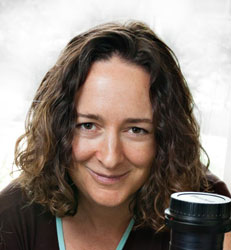
Karen Joyce Osborn is a marine scientist at the Smithsonian's National Museum of Natural History Invertebrate Zoology department. She is known for her work in marine biology specializing in mid-water invertebrates.
Lisa A. Levin is a Distinguished Professor of biological oceanography and marine ecology at the Scripps Institution of Oceanography. She holds the Elizabeth Hamman and Morgan Dene Oliver Chair in Marine Biodiversity and Conservation Science. She studies coastal and deep-sea ecosystems and is a Fellow of the American Association for the Advancement of Science.
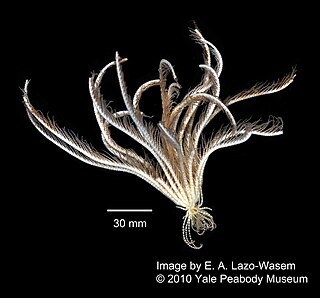
Promachocrinus kerguelensis is a species of free-swimming, stemless crinoids. It was the only member of its genus until several species were discovered in 2023. P. keruguelensis a coldwater crinoid which is found in the seas around Antarctica and surrounding island groups, including under the sea ice.
Bess Ward is an American oceanographer, biogeochemist, microbiologist, and William J. Sinclair Professor of Geosciences at Princeton University.
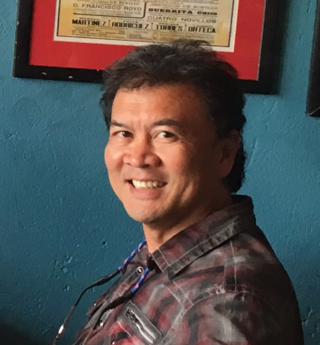
Jose V. Lopez is an American-Filipino Molecular Biologist. He has been a faculty member and Professor of Biology at Nova Southeastern University (NSU) in Dania Beach, Florida, since 2007. Lopez has contributed as a co-founder of the Global Invertebrate Genomics Alliance (GIGA), a community of scientists. He has also participated in the "Porifera—Tree of Life," "Earth Microbiome," and Earth BioGenome projects.









